Chip Antenna Market Overview, 2031
The global chip antenna market was valued at $1.4 billion in 2021, and is projected to reach $5.3 billion by 2031, growing at a CAGR of 14.3% from 2022 to 2031. Chip antennas are particular type of antennas valued for their small footprint. They are most commonly integrated in circuit boards to radiate high frequency electromagnetic waves. They have a limited range, making them optimal for small devices such as cell phones and Wi-Fi routers. Chip antennas radiate and receive electromagnetic waves, however are smaller in size when compared with regular antenna. This means they can often be internalized within small electronic devices; and are inexpensive considering their quality. Chip antennas are the best alternative when a larger-sized antenna is impractical.
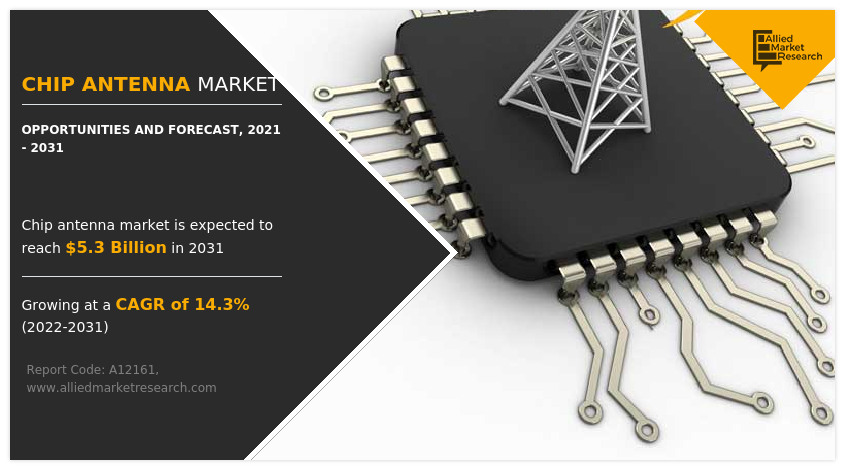
Segment Review:
The chip antenna market is segmented into Type, Application and End User.
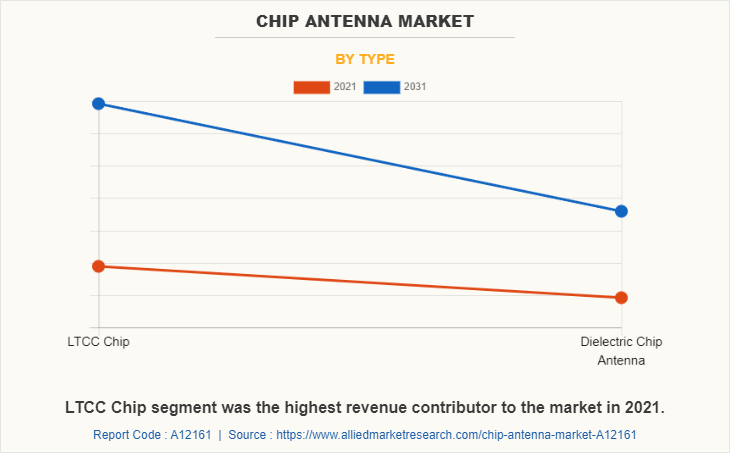
By type, the chip antenna market is divided into LTCC chip and dielectric chip antenna. The LTCC chip segment was the highest revenue contributor to the market in 2021.
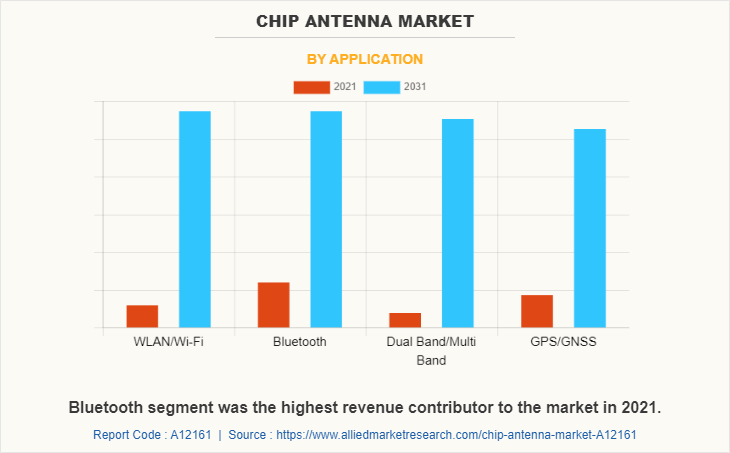
By application, the chip antenna market is divided into WLAN/Wi-Fi, Bluetooth, dual band/multi band and GPS/GNSS. The Bluetooth segment was the highest revenue contributor to the market in 2021.
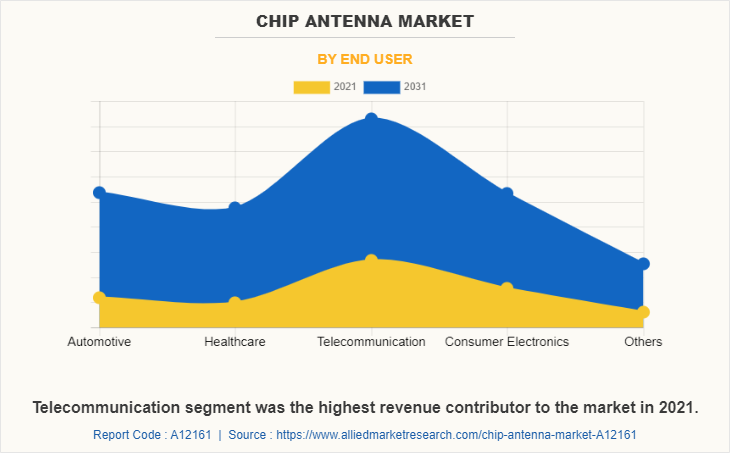
By end user, the chip antenna market is analyzed across automotive, healthcare, telecommunication, consumer electronics and others. The telecommunication segment was the highest revenue contributor to the market in 2021.
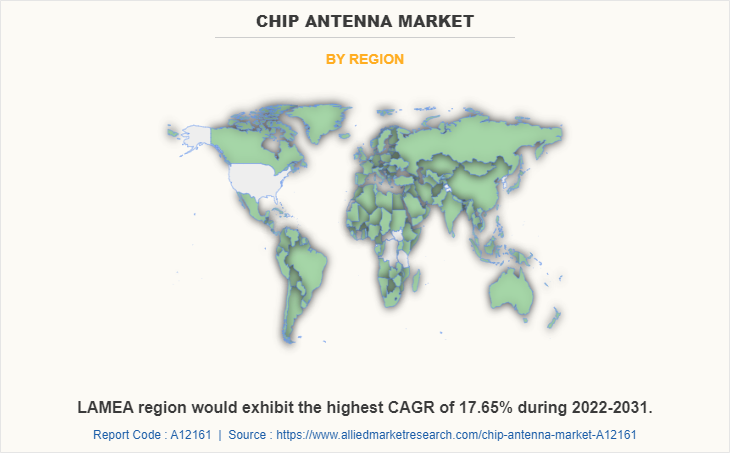
Region wise, the embedded antenna system market trends are analyzed across North America (the U.S., Canada, and Mexico), Europe (UK, Germany, France and rest of Europe), Asia-Pacific (China, Japan, India, South Korea and rest of Asia-Pacific), and LAMEA (Latin America, the Middle East, and Africa).
One means of creating an antenna which can be integrated into a PCB would be the use of fractal geometry. A fractal is a complex pattern constructed from the repetition of a simple shape which maximizes the length or increases the perimeter of the material that radiates an electromagnetic signal. These antennas must be in proportion to the signal wavelength, and the fractal must retain at least two different ratios of the pattern. These antennas can be customized into a variety of footprints and are becoming increasingly common in mobile electronics. Overall, the gain and bandwidth of fractal antennas is exceptional. Fractal antenna designs do not require any additional components to work, which further enables their flexibility.
The chip antenna market is expected to witness notable growth during the forecast period, owing to the emergence of the internet of things (IoT) and machine-to-machine interfaces in different verticals of businesses. The rapid increase in the number of connected devices and growing inclination toward high-speed internet connectivity is fueling the adoption of 5G networks. Technological advancements in wireless communications, such as long-term evolution (LTE), enhanced mobility, and mobile data traffic surge, are driving the penetration of 5G technology. The surge in penetration of 5G network is acting as a major driver influencing the growth of the chip antenna market.
However, lack of skilled employees and high construction and maintenance costs for the infrastructure required to support flat panel antennas are projected to hinder the chip antenna market growth. On the other hand, rise in demand for low-power wide-area (LPWA) networks in IoT applications are key factors driving the growth of the chip antenna market.
Significant factors that impact growth of the chip antenna industry include surge in adoption of chip antenna in Internet of Things devices. Moreover, increase in adoption of chip antenna in consumer electronics industry is expected to drive the growth of the chip antenna market size. However, lack of uniform frequency range for wireless applications might hamper growth of the chip antenna market. On the contrary, development of 5G infrastructure offers potential growth opportunities for the chip antenna market share.
Competitive Analysis
The key players profiled in the report include Johanson Technology, Inc., Vishay Intertechnology, Inc., Antenova Ltd., Mitsubishi Materials Corporation, Taoglas, Sunlord, YAGEO Group, Partron Co., ltd, Pulse Electronics and Ignion are provided in this report.
Key Benefits For Stakeholders
- This report provides a quantitative analysis of the chip antenna market segments, current trends, estimations, and dynamics of the chip antenna market analysis from 2021 to 2031 to identify the prevailing chip antenna market opportunity.
- The chip antenna market research is offered along with information related to key drivers, restraints, and opportunities.
- Porter's five forces analysis highlights the potency of buyers and suppliers to enable stakeholders make profit-oriented business decisions and strengthen their supplier-buyer network.
- In-depth analysis of the chip antenna market outlook assists to determine the prevailing chip antenna market opportunities.
- Major countries in each region are mapped according to their revenue contribution to the global chip antenna market.
- Market player positioning facilitates benchmarking and provides a clear understanding of the present position of the chip antenna market players.
- The report includes the analysis of the regional as well as global chip antenna market trends, key players, market segments, application areas, chip antenna market forecast and market growth strategies.
Chip Antenna Market Report Highlights
| Aspects | Details |
| Market Size By 2031 | USD 5.3 billion |
| Growth Rate | CAGR of 14.3% |
| Forecast period | 2021 - 2031 |
| Report Pages | 113 |
| By Type |
|
| By Application |
|
| By End User |
|
| By Region |
|
| Key Market Players | johanson technology, inc., Ignion, YAGEO Group, Antenova Ltd., Pulse Electronics, Sunlord, Vishay Intertechnology, Inc., Taoglas, Mitsubishi Materials Corporation, Partron Co., ltd |
Analyst Review
The chip antenna market exhibited development potential across industrial and commercial sectors. Furthermore, the contribution to the worldwide market is predicted to grow considerably in the coming years. In addition, rise in adoption of wireless connectivity solutions is driving the growt of the antenna market through digital transformation.
Chip antenna is highly competitive, owing to strong presence of existing vendors. Battery energy storage system vendors are investing substantially in R&D and skilled workforce, and are anticipated to gain a competitive edge over their rivals. The competitive environment in this market is expected to further intensify with increase in technological innovations, product extensions, and different strategies adopted by key vendors.
The demand for chip antenna in consumer electronics is estimated to expand at a rapid pace during the forecast period due to an increase in usage of embedded antenna systems in smart TVs, smartphones, tablets, wearables, gaming consoles, and other peripheral devices for wireless applications such WLAN, Bluetooth, Wi-Fi, and GPS. Moreover, major economies, such as the U.S., China, the UK, and Japan plan to develop and deploy advanced embedded antenna system across various sectors.
The key players profiled in the report include chip antenna market players, such as Johanson Technology, Inc., Vishay Intertechnology, Inc., Antenova Ltd., Mitsubishi Materials Corporation, Taoglas, Sunlord, YAGEO Group, Partron Co., ltd, Pulse Electronics and Ignion.
The global chip antenna market is projected to reach $5.3 billion by 2031.
The global chip antenna market growing at a CAGR of 14.3% from 2022 to 2031.
Pulse Electronics, Antenova Ltd., Taoglas, Ignion, johanson technology, inc., Sunlord, Mitsubishi Materials Corporation, Partron Co., ltd, YAGEO Group, Vishay Intertechnology, Inc.
Asia-Pacific is the largest regional market for Chip Antenna.
The expanding popularity of Bluetooth drives the demand for consumer electronics such as headsets, smartphones, wearables, and game consoles. These factors boost the chip antenna market growth.
Loading Table Of Content...



